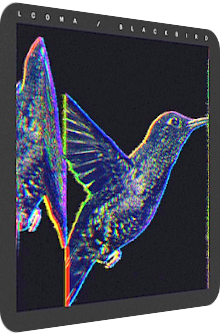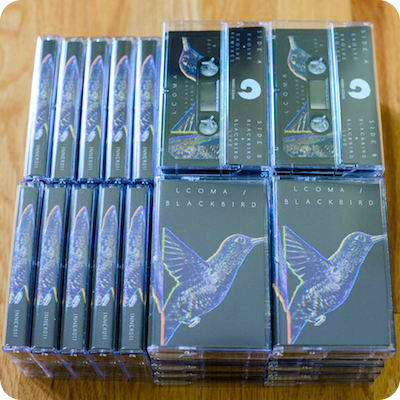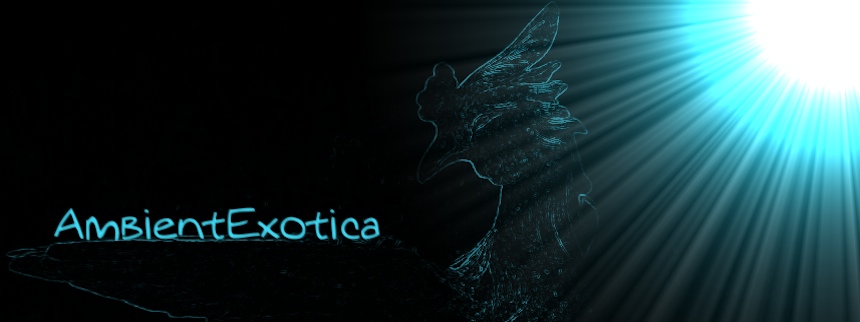
Lcoma
BlackBird
2013
BlackBird is a long Ambient composition of 23+ minutes by the Leeds-based guitarist, synth wizard and recently graduated sound engineer Lcoma aka Liam Coleman, released in November 2013 in a limited run of 30 tapes and in a limitless digital version on Cory Zaradur’s Canadian Inner Ocean Records. The music cassette also sports a live version of the title track in addition to Lcoma's concept EP and previously digital-only Evolve (2012) which itself is remixed by fellow Inner Ocean artists Fontaine, Porya Hatami, Muskoaka and Sima Kim (and strangely enough makes up side A, whereas BlackBird and its live version are the B-sides). In short: lots of music to consume here, although this in-depth review is exclusively about BlackBird. Available to purchase and listen to in full at Bandcamp, BlackBird (stylized in this way by the artist himself) is actually a batch of different vignettes glued together in order to create a versatile long-form piece of serpentine paths and genres, thereby letting it appear as more of a phoenix or canary rather than a raven, crow or mere bat. Although the mood is at times heavy, crestfallen and nebulous instead of Mediterranean or gradually insouciant, Coleman’s sternly metropolitan vision is frequently and regularly elevated into miraculously magic spheres. Hundreds of chirping birds sit on tree tops and watch the glagolithic Glitch glares, rainy storms, cloudy turmoils and arcane guitar-based sparks float by. Or with the words of Liam Coleman sent to me via email: "BlackBird was the first time I felt confident enough to go out and do a full days field recording. Luckily I found a woodland area close to where I currently live in Leeds. In this particular area the blackbird was most prominent throughout my days recording, so I centralised the soundscape around a journey of a blackbird. In this EP I hope you can hear that I'm trying to incorporate more melodic, conventional guitar parts, as well as other instruments and techniques. It's also the first time that I've produced a record that was completely made in one project arrangement with a limited set of audio channels and plug-ins."
 Gotta impress Hitchcock: 30 BlackBird tapes, photographed by Cory Zaradur.
Gotta impress Hitchcock: 30 BlackBird tapes, photographed by Cory Zaradur.
Architecture and nature unite in this piece, and true enough, one has heard that concept hundreds of times before and will continue to encounter it time and again, but there is an aesthetic template grafted onto each second which makes sure that the composition remains coherent… while causing trouble at the same time: aeriform freedom. Like a flying critter, BlackBird is an omnium gatherum of approximately nine different vignettes which form the final shape of the animal. It would be comparably easy to dismiss Lcoma’s endeavor upfront by focusing on the free flow of the segues and stating afterwards that an all too alatoric arbitrariness spoils the meaning of the composition. Thankfully, said aeriform freedom is also cleverly lidded akin to a bird’s instincts which prevent it from flying too high or decreases the likelihood of daring to hover in breakneck speeds over bumpy terrain. The artist hence makes sure that the variety is serving the purpose of dramatization, a feat that is additionally augmented by distinct layers and coatings. A meticulous interpretation of a track like BlackBird is ultimately meaningless, and I’m fully aware of this. Therefore, I am trying to carve out the interplay and interdependency between the textures, the stylistic peculiarities as well as the reappearance of themes, motifs or golden threads. Thanks to Liam Coleman who sent me an advance copy in July 2013 already, I had plenty of flights with that bird and know its opaquely lucent plumage good enough to write an in-depth review.
There are only so many archetypical ways to start a long-winded Ambient track called BlackBird, and Liam Coleman does indeed willfully succumb to the auspicious expectancy, but triples its silkened ethereality: a field recording of an enchanted forest is slowly fading in, not even a cloudlet of portent towers above the verdured underbrushes of the light blue-tinged, partially vitreous-crystalline forest. There are many things to notice right from the get-go, for example the pristine fluxion of the whitewashed riverbed, the delicately gaseous synth strata of felicity and bliss, the moist-aqueous duality of the turquoise xylophone-resembling vesiculations and the cautious protrusions of the revved up synth airflow which accomplishes to gradually swallow the entire scenery and lift it to higher spheres, perhaps akin to Liverpool’s loftiest outlooks, the Liver buildings. This simile does not materialize out of the blue, for Lcoma previously transformed this architecture into music on his split release with Calgary’s Valiska, called Digital Architecture (2013). Indeed, the wraithlike, clinically sterile purity was notable in this release already, and it reappears in BlackBird as well. The prelude of this long Ambient piece is already torn between multitudinous states, Coleman draws a dichotomy which is, at least for the moment, irresolvable, not because it lacks a certain focus or texture-related selection, but due to the clash of tragedy and elation, a turmoil which is nurtured time and again in the feathered animal’s later metamorphoses.
Strangely enough, Lcoma does not maintain the heavier transcendence of the anacrusis for too long and quickly moves on to the next embroidered vignette, a synthetic rain shower of gorgeously texturized blebs, driblets and paroxysms, all of them reigning (or raining?) in unison. More of a short moment of glorified greyness than a turbulent gale, the implied atmosphere allows the chirping birds to return back to the sylvan scene whose rhizomes are now ameliorated with clear cut acoustic guitar licks. The plucked strings are incisive and golden and luckily enough much more related to Dream Pop climes than bucolic bonfire gatherings. Their inclusion is probably the signature element of the whole piece, for they are literally analogue, with a thermal heat and rural luminescence that are not expected in the galactic glissando of the bejinxed wood. And galactic is indeed the key term for the following segue, a noisy Glitch construction of the bit-crushed kind, with silvery bleeps and gunmetal globs gyrating heftily around each other, resemblant of Riot Meadows’ similarly ever-shifting string of vignettes called Natural Circuitry (Twin Springs Tapes, 2013), stoppable only by the vaulted mystique of spheroidal and elasticized electric guitar washes, ophidian hisses and arcane tone sequences in minor. The tonality of New Age becomes entangled with an antrum’s brazen stokehold harshness.
Whatever the polyhedric arabesques of roughness really mean in the given context, they are enormously important for BlackBird’s whole complexion; only their momentary ubiquity and ephemeral fugacity allow interim sunbursts to take over the arrangement. Midway through the polymorphous composition, this tendency becomes clearer when Thomas Köner-esque blizzards blow violently over hyper-fragile scintillae and opalescent coruscations. Nothing is destroyed, everything withstands. The physiognomy of each bit remains unharmed, the interstitial moments of nullity included. 17 minutes into the sanctuary, the apotheosis is slowly erected, as the Ambient piece flies towards its end. The simultaneity of seemingly incompatible layers is yet again celebrated, and once more via the impression of stormy outbursts. The multiple layers of said storm are exclusively celestial and non-threatening. The alloy of coldness can be blamed on the heliospheric conditions, as can the few embedded machine-like staccato bubbles, but the complete appearance of all layers combined is wondrously seraphic and aquiver with miracles and joy. Even the dawn chorus enjoys the setting whose multifaceted structure cross-fades into the lachrymose, heavily reverberated second Dream Pop apparition of afterglow-drowned guitar twangs which cover the murky background with the help of hundreds of birds. What follows in the remaining two minutes depends more than anything on the listener’s mood and insight, as the final stage leaves a potentially threnodic aftertaste. The synths become more nebulous, the half-tone steps and masked guitar chords become harder to pinpoint as they fade into the distance for good, with cavalcades of birds remaining in place for the last seconds before the composition ultimately ends. Bye bye, BlackBird.
BlackBird easily escapes any prerogative of interpretation, and even though I was willed throughout the main body of the review to not overanalyze or exaggerate the biological characteristics of Coleman’s aural species, I have of course crossed the paths to ornithology several times. After showcasing the layer entanglement and overall features of Lcoma's feathered rascal, there are also things, concepts or overarching markers which are amiss. The most notable omission of this piece is a moment of revelation, of some kind of narrative fulfillment or plot twist, and yes, I am aware of the fact that I am reviewing an Ambient piece, not a pulp magazine. So naturally, the vast majority of Ambient tracks lacks an embroidered story, and I do not demand it of the Leeds-based artist, but seeing that BlackBird visits so many different locations, draws from several textures and at the same time revisits them time and again, the piece as a whole could have been supercharged with hidden trapdoors, masked punchlines or camouflaged wisdoms, or in short: epiphany. But to no avail, the approximately nine vignettes do – if you allow me the worst of all puns – indeed chirp for themselves.
However: what Coleman may lack as a storyteller, he delivers as a producer and weaver of stupendous textures. And indeed, BlackBird’s superstructure is hypercharged with plasticity and placidity, wideness and wilderness, crimson crystals and grayish grottos; storms are blowing through the land, elemental forces clash and coerce, Medieval guitar strings and their alkaline-electric brethren dominate to equipollent parts, and last but not least, there is that kind of purity imposed which emanates coldness and cleanliness. If these descriptions seem de trop, one possible reason could be the superimposed layering techniques of the various aural images. From flights up in the air above fogbanks near a forest’s sphere of action, over U-turns in close proximity to the skyscrapers of British megacities, to terraqueous pre-Holocenic calderas or cavities and way beyond, BlackBird is about vestibules leading to freedom and paths to contemplation. While these allegations seem yet again like interpretations, they are more based on feelings and impressions rather than endeavors of dissection. In the end, it comes down to this, all quasi-erudite explications aside: if you are fond of a splendidly produced Ambient track with parallax layers, enthralling patterns and textures, shifting landscapes and reoccurring threads, BlackBird proves to be a great ride; it is no joyride and at times quite mournful and lugubrious, but ethereality has never been solely about elysian bliss.
Further listening and reading:
- You can order the tape and listen to it at Bandcamp.
- Liam Coleman & Inner Ocean Records are on Twitter: @L_coma & inner_ocean.
Ambient Review 274: Lcoma – BlackBird (2013). Originally published on Oct. 16, 2013 at AmbientExotica.com.
